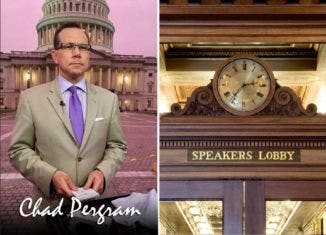1965
By nature, politicians are a forward-looking group. They try to correct the injustices of the past. They don’t dwell on what’s already downstream. They’re always looking forward to the next legislative fight. The next debate. The next election.
But as House Democrats approved their massive health care reform bill over the weekend, it was clear they were living in the past.
1965, to be exact.
The 1965 thematic emerged Saturday, the day before the House okayed two major health care reform packages. Thousands of health care opponents descended on Capitol Hill to protest the effort. They were a vocal lot. But most made their views known peacefully, content to sing “God Bless America” or “This Land Is Your Land” on the West Front of the Capitol.
But echoes of a bygone era permeated the demonstrations.
Specifically, 1965.
Reps. John Lewis (D-GA) and Andre Carson (D-IN), both members of the Congressional Black Caucus, say that a group of protesters taunted them and lobbed the N-word as they walked from the Cannon House Office Building to the Capitol.
“They were just shouting. Harassing,” Lewis said. “People being downright mean.”
Lewis was one of the most prominent figures of the civil rights struggle. He spoke alongside Dr. Martin Luther King at the Lincoln Memorial during the “I Have a Dream” speech. And Alabama state troopers fractured the Congressman’s skull as he led a march across the Edmund Pettus Bridge in 1965. The incident became known as “Bloody Sunday.”
“It’s okay, I’ve faced this before,” said Lewis of Saturday’s contretemps. “I haven’t heard anything like this in 40, 45 years. Since the march to Selma, really.”
Carson was born nine years after Bloody Sunday. He conceded he wasn’t used to such slurs.
“The beauty is that I was walking with a good sage who had been there before,” Carson said, who was alongside Lewis at the time.
Rep. Emanuel Cleaver (D-MO) says a protester spit on him as he walked from the Capitol to the Cannon Building. Police detained the person in question. But Cleaver didn’t press charges.
Many protesters demanded video and audio proof that someone jeered the lawmakers with an epithet. And some questioned the veracity of the reports.
These episodes unfolded amid the health care debate, one of the most-divisive legislative battles to rock Congress. Perhaps since civil rights.
President Lyndon Baines Johnson first proposed his “Great Society” programs during his 1965 State of the Union speech. America was in turmoil with the civil rights fight. And many of LBJ’s programs were tailored to bring about racial equality and slash poverty.
And in 1965, Congress created Medicare, a health insurance program for the elderly.
1965 was an historic year. And it had been clear for months that House Speaker Nancy Pelosi (D-CA) wanted to make history with the health care bill.
When I queried the Speaker last July 23 about progress on health care, she briefly turned the tables before answering.
“Don’t you feel excited to be a part of this historic, momentous thing?” she asked me.
“It’s historic,” Pelosi intoned last September 29.
During an October 29 press conference, the speaker said that “we are brought to this historic moment for our nation and our families.”
In her speech before the original health care bill in November, Pelosi called it an “historic moment for our nation.”
And leading up to Sunday night’s votes, the speaker proclaimed “tonight we will make history.”
House Democrats wanted to emphasize the historic point on Sunday. As they emerged from a meeting in the Cannon Caucus Room, the Democratic leadership prepared to go back in time. No need for Christopher Lloyd’s wild hair or a silver DeLorean sporting gull-wing doors. No. The Democrats’ flux capacitor was more rudimentary. Their time machine involved a gavel, a hostile crowd and a walk.
“We’re locking arms behind a man who led a nation across a bridge (45) years ago,” said House Democratic Caucus Chairman John Larson (D-CT) of John Lewis. “Today’s he’s going to lead us across this street to vote for health care for the American people.”
Then Pelosi arrived, wielding a gigantic wooden gavel. It looked kitschy. Like an item one could buy alongside oversized Crayola Crayons or Oreos the old Think Big store in New York. The gavel was so large that Pelosi had to clasp it with both hands.
It was the gavel that Rep. John Dingell (D-MI) used to close the vote that created Medicare in 1965.
“And I will use it this evening when we cast a very successful vote for this important legislation,” Pelosi said.
Pelosi then locked arms with Lewis, Larson and House Majority Leader Steny Hoyer (D-MD) to defiantly walk into the sea of protesters swarming Capitol Hill.
They met a hale of boos and chants of “kill the bill” as they marched symbolically across the street to the Capitol amid their political foes, Independence Avenue doubling as the Edmund Pettus Bridge. Reporters and photographers scrambled to snap pictures and videotape this walk as a phalanx of U.S. Capitol Police formed a human wall around the lawmakers. And while they aren’t anywhere in the same galaxy as the Alabama State troopers in Selma a few overly-aggressive officers shoved reporters and unleashed verbal judo on those trying to document the moment.
For a moment, it was 1965.
Later that night, the House approved both health care measures, sending one to the president and one to the Senate.
“I consider this to be the civil rights act for the 21st century,” declared House Majority Whip Jim Clyburn (D-SC).
And during her floor speech, Pelosi quoted John Lewis and his messages during the civil rights era.
“We may not have chosen the time, but the time has chosen us,” she said.
But House Democrats did choose a time. They chose 1965. The tapped 1965 because of the legislative symbolism that Medicare embodies and the social tension epitomized by John Lewis and his historic march.
But in this political stagecraft, Democrats should be wary of 1965.
There were midterm elections in 1966. And Democrats lost 47 House seats.
- Chad Pergram covers Congress for FOX News. He’s won an Edward R. Murrow Award, the Joan Barone Award and a National Headliner Award for his reporting on Congress.
- The Speaker’s Lobby refers to a long, ornate hallway that runs behind the dais in the House chamber. Lawmakers, journalists and aides often confer there during votes.

